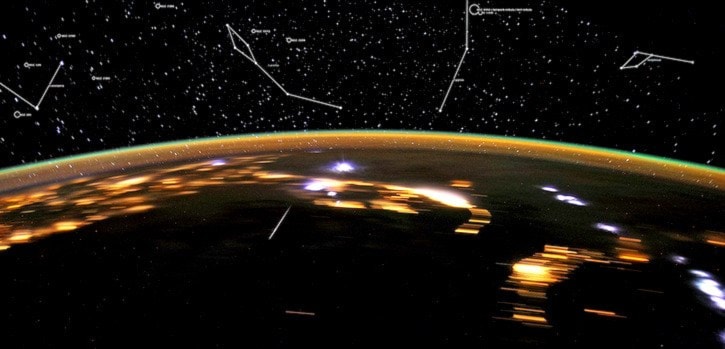Lyrid Meteor Shower
These meteors are active from April 16 to 25 and reach their highest concentration the morning of April 22. They will be travelling at 66 km per second when they hit our atmosphere.
The radiant (the part of the sky where they appear or radiate from) is just above and to the right of the constellation of Lyra, the Lyre. If you don’t know where in the sky that is, just look east and you’ll be in the ballpark. Since the moon rises quite late, the best viewing time will be between 1 a.m. and 3 a.m. on April 22. Good thing that’s a Saturday. I suggest staying up late then sleeping ‘till noon.
Normally, this meteor shower is an afterthought, but this year is expected to be different. With the moon rising around 4 a.m., this should be the meteor shower with the best viewing conditions all spring and summer. From a dark location you should be able to see 18 meteors per hour. Just remember to bundle up, turn the lights off, and bring a fortifying drink. Oh, and to see longer meteor streaks, look slightly to the north or south of east.
The Planets
Mercury’s best evening appearance of 2017 happens April 1. No, I’m not pulling your leg. It should be visible above the horizon about 30 minutes after sunset, disappearing a little over an hour later. It should be bright enough to show up easily against the fading twilight. Mercury will disappear into the sun’s glare around mid-month. If you have a telescope you will want to look at this innermost planet in the first week of April.
Above Mercury and slightly to the left on April 1, you will see Mars. Mars will dim a bit as it lingers above the western horizon at sunset and will set before midnight. Unfortunately, this is not a good month to use a telescope on the ‘Red Planet’ as even the best instruments will only show a featureless disc.
Jupiter will reach opposition on April 7 in the southeast. What is opposition? It’s when Earth lies directly between Jupiter and the sun, meaning Jupiter is closest to Earth and in view all night. Opposition is also when Jupiter shines brightest and appears biggest, with the most detail, through a telescope. Midnight is the best time to look. Look closely and you should see that it is more wide than tall, even through smaller telescopes. Jupiter is the brightest “star” in the sky until Venus rises, so it’s hard to miss. A nearly full moon will pass close to Jupiter’s north just after sunset on April 10.
Saturn rises in the south about 1:30 a.m. at the beginning of the month and will rise earlier each day until it is rising at 11:30 p.m. Starting in the southern sky, it will move slowly eastward until April 6, when it will change course and start heading west. It will reach its highest point on April 6, then begin sinking toward the horizon.
If you look through a telescope at Saturn on April 6 and 22, you should be able to see its moon, Titan, just above its north pole. Look again on April 13 and 29 to see Titan just below Saturn’s south pole. Even the smallest telescope should help you see Titan, but you will need a larger one to see three more moons orbiting Saturn closer than Titan: Tethys, Dione and Rhea. Saturn will be just to the east of the crescent moon on April 16 and 17, which should make for a good photo opportunity.
On April 1, Venus rises an hour before dawn but doesn’t climb high above the horizon. It will rise a bit earlier each day and climb higher into the eastern sky throughout April, reaching its highest point April 30. It will also appear to grow brighter, reaching its brightest morning appearance of the year the same day. On April 23, it will rise in the morning with the crescent moon just off to the right — another good photo opportunity.
Neptune returns to the sky at month’s end, but barely rises over the eastern horizon before morning twilight begins. It will be extremely difficult to spot this planet.
Comet 41P/Tuttle-Giacobini-Kresák: I’m not sure how visible this comet will be as comets are notorious for defying brightness predictions, but I thought I’d throw it in. This one is supposed to be visible with the naked eye from a very dark location, but more likely you will need binoculars or a telescope to see it. Look for it in the constellation of Draco the Dragon, which lies between Ursa Minor (Little Dipper) and Ursa Major (Big Dipper). It will be the closest to Earth on April 1 and closest to the sun on April 13. The best time to try to find this dirty snowball is in the moonless hours before dawn. Personally, I’m hoping we have a repeat of 1973 when this comet’s surface cracked and gushed gas and dust for a couple of weeks. But I will be happy with a binocular view. Let’s keep our fingers crossed.
